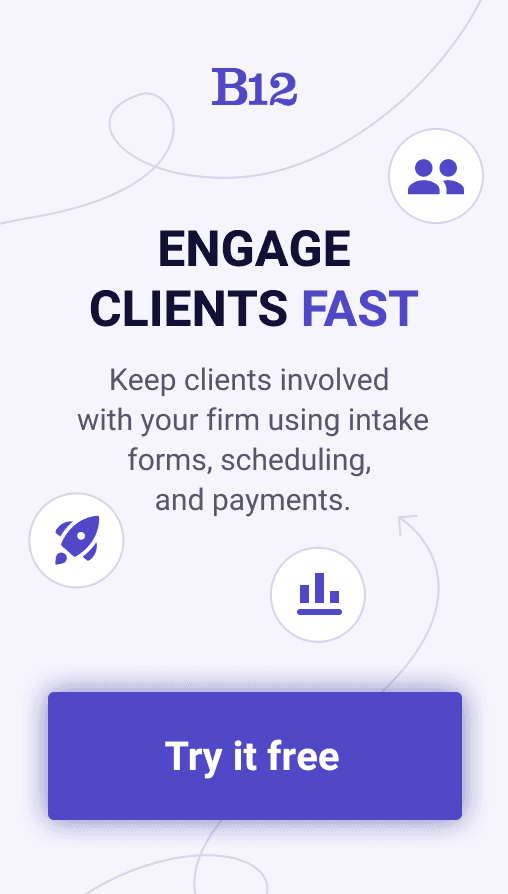Build an AI website in 60 seconds
AI generates your personalized website instantly with built-in scheduling, payments, email marketing, and more.
Start for free
Email etiquette 101: Using Bcc vs. Cc

There are nearly 4.26 billion email users worldwide, which is over half the world’s population. It’s no surprise that email dominates communication in the workplace as a fast, secure way to share important information, especially with multiple recipients. In fact, the average American worker receives 126 emails per day!
No matter how ubiquitous email is, email etiquette is still important, especially in professional settings. A well-composed email requires a formal salutation, a personalized signature, a clear subject line, and thorough proofreading, to name a few. Today, we’re going to focus on one critical aspect of how to start an email — placing recipients in the proper fields.
Recipient fields are a little more complicated than you’d think. When you go to write a new email, there are three recipient fields: To, Cc, and Bcc. We’re here to define each of these and explain when and how to use them. By using these fields correctly, you’ll ensure smooth communication with every email you send and avoid embarrassing mistakes in an email thread.
What is the “To” field?
The most straightforward recipient field is the “To” field. It’s meant for the main recipients of your email. Your message should directly concern these recipients. Furthermore, you can expect a direct reply or action from “To” recipients in response to your email. You can include multiple people in the “To” field, as long as they all meet these criteria.
Keep in mind that all recipients of the email, even if they’re “Cced” or “Bcced,” will be able to see who is placed in the “To” field.
When should you use the “To” field?
Use the “To” field to address the primary person your email is intended for.
For example, if you write an email asking about the status of a project, place the projects’ main contributors in the “To” field. By doing so, they will know they’re expected to respond or take appropriate action. They will also receive all future email replies included in the email chain.
Or, if you are writing directly to a client, place their email in the “To” field. While you may share this email with colleagues by “Cc-ing” or “Bcc-ing” them, the email’s primary recipient is the client. Thus, they belong in the “To” field.
What does Cc mean in email?
“Cc” stands for “carbon copy.” When you place a recipient in the “Cc” field, they’ll receive a copy of the email. However, it’s implied that these other recipients aren’t the direct recipients in this conversation. That’s why “Cc” is commonly understood to mean “courtesy copy.”
The primary purpose of the “Cc” function is to keep someone in the loop, even if a message doesn’t directly concern them. “Cc” recipients are not expected to take action or respond to the email, but they can if they want to. They will also receive all associated email chain responses. Like with the “To” field, all recipients will be able to see who is “Cced.”
When should you use Cc?
Here are some examples of appropriate uses of the “Cc” field. Use it when you want to:
Keep someone in the loop
Use “Cc” to keep someone updated on important details that don't require their immediate, direct response. For example, allow management and other concerned parties to remain informed on the status of an important project.
Convey urgency
By “Cc-ing” higher-ups in the company, the “To” recipients will understand that the email is essential. For example, you might “Cc” your boss when requesting that a client sends over time-sensitive information.
Take on other team members' tasks
When you do work that’s usually done by someone else, like for a coworker that’s on vacation, keep them updated on their work's status by “Cc-ing” them in all relevant communications. For example, “Cc’ them on emails between you and their clients.
Introduce two contacts
When you introduce two people via email, you can use “Cc” to provide them each others’ emails. Then, they can introduce themselves to each other and communicate in the future.
In 60 seconds, generate a professional, client-engaging website for free.
When to avoid using the “Cc” field while sending emails
While there are many reasons to use the “Cc” field, mull yours over before you click send. “Cc” is often used too liberally.
It’s tempting to “Cc” people on all matters that loosely involve them. However, spamming coworkers with irrelevant email chains is not recommended. It can waste their time and reduce the significance of future emails. Overusing “Cc” may cause people to ignore your emails going forward. Sometimes it can even come off as passive-aggressive.
Unless it’s truly appropriate to use the “Cc” feature, consider sharing information to relevant parties in person or within a forwarded email. Add context as to why the info concerns them.
Here are some more situations where you should avoid using the “Cc” field:
If you’re calling someone out
If your email is meant to embarrass someone or call them out publicly, hold off. For example, it’s in poor taste to “Cc” your boss an angry email toward another coworker where you point out how they messed up. Handle such interactions in private.
If you don’t have their consent
If your communication involves multiple parties, you should get their approval before “Cc-ing” someone new within the email chain. Otherwise, you risk providing the “Cc-ed” recipient access to private or classified information without proper authority.
If your Cc recipient list is long
If you notice you’re “Cc-ing” more than 5 or 6 people, consider using “Bcc” instead. Including too many people’s emails can be distracting. It can also harm the recipients’ privacy, especially if they don’t already know each other.
If you expect a response
As we’ve explained, the “To” field should always be used if you expect a direct response. “Cc-ing” sends the message that your email is simply a courtesy. Thus, it’s misleading to “Cc” if you want a reply.
What is Bcc?
“Bcc” stands for “blind carbon copy.” As the name suggests, “Bcc” keeps the recipients’ emails hidden. Thus, the BCC list is a secret to everyone but the sender.
Bcc functions differently in relation to email threads. While “To” and “Cc” recipients will receive replies going forward, “Bcc” recipients won’t. They’ll only receive the initial email. Thus, you’ll have to forward any future emails that may concern them.
“Bcc” functions this way because it’s usually intended for impersonal, mass emails that don’t warrant a response. Also, it wouldn’t be appropriate for another recipient to send an email to a list they didn’t know about and didn’t create.
However, take note that when a Bcc recipient “replies to all,” their recipient status will suddenly be exposed to the rest of the recipients. If you believe a “Bcc” recipient may respond, consider using “Cc” instead to ensure transparency.
When should you use the “Bcc” field? This “Bcc” field is best used when you want to streamline your email’s appearance and keep recipients’ from seeing each others’ emails. While this sounds a little shady, it’s not meant for devious purposes. It’s primarily meant to protect the privacy of your recipients.
When to use Bcc
When sharing a company newsletter: When making use of your newsletter ideas in a company newsletter, keep your email list private by using “Bcc”. Otherwise, it will expose your subscribers to each other without their consent.
When using an extensive mailing list
“Bcc” is great for sending an email to a large mailing list. If your email addresses the entire student body of a college or all employees of a large company, “Bcc” is preferable. It also prevents a long list of emails from distracting from your email’s content.
When your recipients don’t know each other
“Bcc” protects the privacy of recipients. This is very important if your mailing list is made up of strangers who don’t know each other.
For emails that don’t warrant responses
When sending an impersonal email, “Bcc” is suitable. For example, if you send a business announcement, like updated contact information, a new website promotion, or an announcement about a new CEO, use “Bcc.”
To expose something nefarious
On very rare occasions, “Bcc” can help you expose problematic behavior. Like with “Cc,” this should be done with extreme discernment. However, if you’re dealing with a problem that warrants HR’s attention, you could “Bcc” them in an email that exposes inappropriate communication taking place at work.
To sum it up, the best applications of the “Bcc” field are impersonal emails that are being sent to a large email list of people who don’t know each other. By using Bcc, you respect their privacy and avoid frustrating email chains.
When to avoid using Bcc
When using “Bcc”, you should avoid any applications that could be interpreted as shady, underhanded, or inappropriate. As a general guideline, avoid using “Bcc” if:
The message is personal: Using “Bcc” in a personal email can easily cross the line into inappropriate territory. With personal matters, transparency is imperative. Otherwise, you’re essentially allowing digital eavesdropping to take place.
You’re emailing coworkers: In general, it’s best to avoid using “Bcc” at work when emailing your coworkers. It doesn’t look good on you and will reduce your coworkers’ perception of your workplace integrity. Keep things transparent by sticking with “CC” and “To.”
A reply from the “Bcc” recipient would be awkward: If you “Bcc” someone, it’s always possible that they’ll reply. If this could be detrimental, avoid it. For example, don’t “Bcc” your friend when recommending them to your boss for an open position. If they were to thoughtless reply “thank you,” intending the message for you, you’d suddenly be in a very awkward position.
Summary: When to use To vs. Bcc vs. Cc
When reviewing the differences between these fields, use these general guidelines:
- If you expect a direct response or action, use the “To” field.
- If you want to keep people in the loop or send copies in a transparent way, use the “Cc” field.
- If someone is not meant to be a main recipient, use “Cc.”
- If you want a “To” recipient to know other important people are aware of the correspondence, use “Cc.”
- If you want to maintain an inclusive email chain, use either “To” or “Cc.”
- If you are sending an impersonal email or one with a large mailing list, use the “Bcc.”
- You want to protect the privacy of recipients who don’t know each other, use “Bcc.”
- If you want to share information with someone discreetly, use “Bcc,” but exercise ethical discretion when doing so.
Look professional via email every time
Now that you understand the differences between these fields, you can set up and send emails with intention and courtesy. You’ll ensure your emails appear professional and respect recipients’ boundaries and privacy. You’ll also avoid awkward email blunders that hurt others or harm your reputation.
To send better emails with efficiency, a platform like B12 can help. B12 designs beautiful, professional websites backed by AI, with built-in email marketing tools like recurring email automation, prewritten email messages you can customize, and email metrics. You can send emails directly from B12 that automatically match your branding, so you save time and offer contacts a cohesive experience. B12 also offers online payments, scheduling, contracts and eSignatures, and more.
Establish credibility for your business
Receive resources on how to always appear professional and impress potential clients
Draft your site in 60 seconds
Get an AI website made specifically for you that's free to launch.
Start for free ✨No credit card required
Spend less time on your website and more time growing your business
Let B12 set up your professional online presence with everything you need to attract, win, and serve clients.




